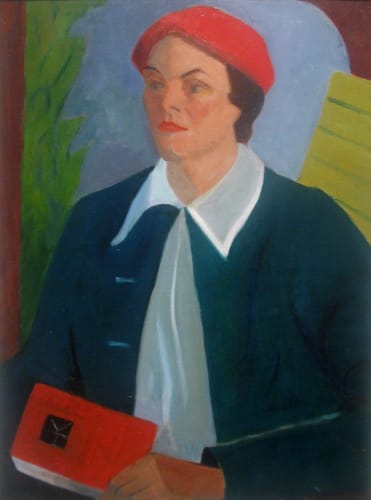Cissie Kean was born in London in 1871 into a wealthy family of German coffee merchants. Although her interest in painting was established at an early age, her family did not think that a career as a painter would be compatible with her social background. After sustaining a severe injury during a riding accident as a young adult, Kean decided to dedicate her life to painting. She went to Paris where she studied for a number of years at the world-reknowned Académie Julian. The work of André Lhote and Jean Marchand influenced her painting during this first Paris period. Before the First World War, Kean travelled extensively to Italy, Spain and Brazil, meticulously recording her changing surroundings in her sketchbooks, which she then used to work into watercolours and oil paintings.
At the onset of the War, Kean returned to her family in London. She set up a studio and travelled around England with her friends, fellow female artists Bertha Johnson and Lila Sampson, and regularly attended painting groups. During 1916-1919, Kean found herself painting in Chipping Campden with New Zealand artist Frances Hodgkins.
After the Great War, Kean travelled back and forth between London and Paris, with breaks in the Mediterranean. During the 1920's, she was working under André Lhote again, exploring the human figure through the Cubist style. At the time, she was also attracted to the Purism of Fernand Léger and Amédée Ozenfant. Kean spent time in Léger’s atelier where she found her true artistic identity working in oils. She started experimenting with keeping the very careful balance between representation and abstraction which the Cubists sought to maintain. Following Léger’s approach to portray the subjects close to the picture plan, the figures and objects in Kean's canvases are often simplified in an attempt to imbue them with a sense of greater vigour, movement and monumentality rather than to analyse their structure.
Back in London, Kean was one of the founding members of the Three Arts Club. In 1936, she took up residence in the prestigious new apartment block at 49 Hallam Street, in London's fashionable Fitzrovia, where Augustus John and Dylan Thomas bolstered the bohemian reputation of the area. It remained her home until shortly before her death in 1961.
In keeping with her family's wishes, Cissie instructed that her papers be destroyed after her death, but one of her closest friends, Lila Sampson, an aunt of Roger Hilton, recounts in her diaries the time these ladies spent studying in Paris before the First World War. Here they developed their skills as miniaturists, with Cissie winning a medal at the Académie Julian in 1906.
Cissie Kean was an independent, single woman of means and was able to live her dream. However, at the request of her family, she remained in the background and her work was never commercially accredited.
Four decades after her passing, Whitford Fine Art brought Cissie Kean back onto the market with two retrospective exhibitions (in 1999 and in 2002) bringing back into the limelight her life-long dedication to painting, her ambitions and identity as a female artist.
